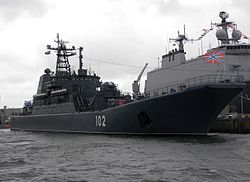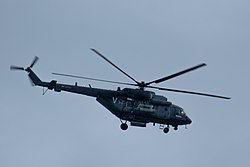2021–2022 Russo-Ukrainian crisis
The 2021–2022 Russo-Ukrainian crisis was a military buildup and international crisis between Russia and Ukraine. It started on March 3, 2021 and escalated in late 2021, when NATO told the Kremlin that they would support Ukraine. The crisis has caused international tension, also involving NATO, the European Union, the Lublin Triangle,[11] the Union State, the Commonwealth of Independent States and the CSTO.
| 2021–2022 Russo-Ukrainian crisis | |||||
|---|---|---|---|---|---|
| Part of the Russo-Ukrainian War | |||||
 Map of the assessment of US intelligence on the movement of Russian troops near the border with Ukraine as of December 3, 2021. It is estimated that Russia has deployed about 70,000 troops, mostly at a distance of 100–200 km from the Ukrainian border. It is estimated that the number could increase to 175,000. | |||||
| |||||
| Belligerents | |||||
|
Supported by:
|
Supported by:
| ||||
| Commanders and leaders | |||||
|
Supported by:
|
Supported by:
| ||||
| Strength | |||||
|
Training mission: |
| ||||
The crisis has been described as one of the most intense since the Cold War.[12][13][14]
The crisis ended on 24 February 2022 when Russia invaded Ukraine.
2021–2022 Russo-Ukrainian Crisis Media
Sergey Karaganov, who is considered close to Putin, formulated many of the core ideas that led to Russia's invasion of Ukraine
A map showing two alleged Russian plans published separately by Bild and the Center for Strategic and International Studies (CSIS).
An Iskander-M, launched in 2018
The Kaliningrad, a Ropucha-class landing ship, was among the six landing ships departed for Sevastopol on 8 February 2022.
Russian helicopter Mil Mi-8AMTSh in Minsk, Belarus (23 February 2022). Note the number RF-91175 and a sign "V". The photo was made a few hours before the Russian invasion of Ukraine from a point near an established air route between Mačuliščy (Machulishchy) airbase and a major helipad near Minsk. Similar photos of Russian helicopters were made on 13 February 2022 from this point:
President Putin, alongside Denis Pushilin and Leonid Pasechnik, signs decrees recognizing the independence of the self-proclaimed Donetsk and Luhansk people's republics on 21 February 2022.
Notes
- ↑ Czech Republic sent weapons and instructors.[1][2]
- ↑ Estonia sent weapons and instructors.[3][2]
- ↑ Latvia sent weapons and instructors.[4][2]
- ↑ Lithuania sent weapons and instructors.[5][2]
- ↑ Canada sent instructors.[2]
- ↑ Poland sent instructors.[2]
- ↑ Spain sends two warships to the Black Sea and plans to send fighters to Bulgaria.[6][2]
- ↑ The United States sent weapons and instructors.[7][2]
- ↑ The UK sent weapons (specifically NLAW ATGMs) and instructors.[8][2]
References
- ↑ "The Czech Republic is ready to provide Ukraine with weapons and military equipment". Radio Svoboda. Retrieved 19 December 2021.
- ↑ 2.00 2.01 2.02 2.03 2.04 2.05 2.06 2.07 2.08 2.09 2.10 The Military Balance 2021//International Institute for Strategic Studies
- ↑ "The United States has allowed the Baltic states to hand over American weapons to Ukraine". Deutsche Welle. Retrieved 9 December 2021.
- ↑ "Latvia will provide arms to Ukraine". Deutsche Welle. Retrieved 20 January 2022.
- ↑ "Литва передала Україні партію військової допомоги" [Lithuania handed over a consignment of military aid to Ukraine]. Deutsche Welle (in Ukrainian). Retrieved 9 December 2021.
{{cite web}}: CS1 maint: unrecognized language (link) - ↑ "España moviliza dos buques y ofrece cazas a la OTAN en plena escalada con Rusia sobre Ucrania" [Spain mobilizes two ships and offers fighters to NATO in full escalation with Russia over Ukraine]. ElDiario.es (in Spanish). 20 January 2022. Retrieved 21 January 2022.
{{cite web}}: CS1 maint: unrecognized language (link) - ↑ "US small arms and ammo arrive in Ukraine as Pentagon details troops to train country's military". CNN. Retrieved 11 December 2021.
- ↑ Larisa Brown, Defence, ed. (18 January 2022) (in en). British anti-tank weapons sent to defend Ukraine from Russia. The Times. . https://www.thetimes.co.uk/article/british-anti-tank-weapons-sent-to-defend-ukraine-from-russia-2f5lbzn8v. Retrieved 19 January 2022.
- ↑ Fox, Greg (10 December 2021). "165 members of Florida National Guard in Ukraine". WESH.
- ↑ UK gives Ukraine anti-tank weapons as Canada sends special forces. 18 January 2022. https://www.aljazeera.com/news/2022/1/18/uk-gives-ukraine-anti-tank-weapons-as-canada-sends-special-forces. Retrieved 19 January 2022.
- ↑ ""Люблінський трикутник": з Путіним треба не розмовляти, його треба стримувати". Ukrinform.
- ↑ Sanger, David E. (10 January 2022). "In U.S.-Russia Talks, How Far Can Putin Turn Back the Clock?" (in en-US). The New York Times (Washington D.C.). . https://www.nytimes.com/2022/01/10/world/europe/us-russia-cold-war-ukraine.html. Retrieved 21 January 2022.
- ↑ "Putin to mull options if West refuses guarantees on Ukraine". Associated Press. 26 December 2021. Archived from the original on 22 January 2022. Retrieved 21 January 2022.
- ↑ Gongloff, Mark (13 January 2022). "Putin Launches an Unwelcome Cold War Reboot". Bloomberg L.P. Archived from the original on 21 January 2022. Retrieved 21 January 2022.






